Top News
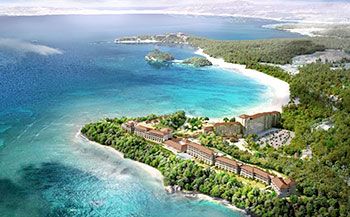
October 20, 2017 Ryukyu Shimpo
Hawaiian luxury resort hotel “Halekulani” announced that it will open a resort hotel in Nakama, Onna Village where Mitsui Fudosan is carrying out hotel construction.
Halekulani is a wholly-owned subsidiary of Mitsui Fudosan, and it will be its first foray into Japan. The hotel is scheduled to open in the summer of 2019.
The name of the hotel is “Halekulani Okinawa.
” It will be a massive hotel with ten floors and a total floor area of 41,746 square meters on a site of 87,145 square meters.
The hotel has all 360 rooms facing the ocean, making use of the 1.7-kilometer stretch of coast on the hotel premises.
An outdoor pool allows guests to view the sea while swimming, and there is also a spa that functions as a hot spring.
An indoor pool, a fitness gym, and restaurants are also provided.
Jun Yoshie, who was the general manager of The Ritz-Carlton Okinawa, has been appointed as the first general manager of Halekulani Okinawa.
In Hawaiian, Halekulani means “a house befitting heaven.
” Halekulani is a hotel in Waikiki on the island of Oahu, Hawaii.
This year marks the 100th anniversary of the business. A restaurant in the hotel was top for 28 consecutive years in a ranking by the National Automobile Association, which is comparable to the French guidebook “Michelin.”
(English translation by T&CT and Megumi Chibana)
Go to Japanese
October 23, 2017 Ryukyu Shimpo
The 48th Lower House elections were held on October 22, and the Liberal Democratic Party (LDP) were able to independently win more than the 233 seats needed for a majority in the 465-seat Parliamentary house, and decided to continue the administration of Prime Minister Shinzo Abe.

Seiken Akamine (center) celebrating his victory with supporters. October 22, Naha
Social Democratic Party incumbent Kantoku Teruya, 72, was re-elected to his seat in the No. 2 electoral district.
In the No. 1 district, where the vote was delayed until the October 23 in Zamami with typhoon No. 21 approaching, Japanese Communist Party incumbent Seiken Akamine, 69, was re-elected. In the No. 3 district, which includes Uruma, where voting was also delayed, Independent incumbent Denny Tamaki, 58, was re-elected. Lastly, in the No. 4 district, where voting was delayed in Nanjo, LDP candidate Kosaburo Nishime, 63, regained his seat. Three of the four district winners were part of the “All Okinawa” faction, which opposes the new base construction in Henoko.
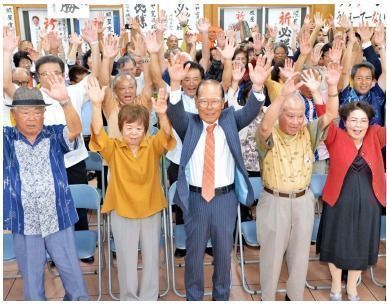
Kantoku Teruya (center) celebrating his victory with supporters. October 22, Ginowan
While the camp hoped to make a strong statement against the base construction with election victories, their inability to capture all of Okinawa’s seats left the movement showing some cracks.
Liberal Democratic Party incumbent Konosuke Kokuba, 44, and Japan Innovation Party candidate Mikio Shimoji, 56, both who lost to Akamine in the No. 1 district, recaptured their seats in the Kyushu proportional bloc.
Voter participation increased 4.02 points compared to the 2014 elections to 56.38%, barely escaping a second straight year of historically low turnout.
In the No. 1 district, Akamine was one of the first proponents of the “All Okinawa” framework in support of Governor Takeshi Onaga, winning for the second straight time the single seat district for the Communist Party.

Denny Tamaki (center)celebrating his victory with supporters. October 22, Okinawa
In the No. 2 district, Teruya brought out his reformist base in addition to a healthy amount of conservatives and moderates, coasting to an easy victory.
In the No. 3 district, Tamaki ran as an independent due to the reorganization of the opposition party coalition, but from the support he gained from voters opposed to Henoko base construction, he enjoyed a lead from the early stage
s of the race.
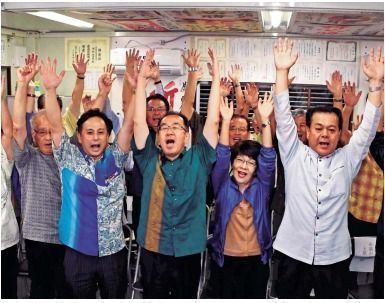
Kosaburo Nishime (center) celebrating his victory with supporters. October 22, Haebaru
In the No. 4 district, Nishime leaned on strong party support and his experience as Senior Vice Minister, and earned the support of his district’s mayors, taking the election.
(English translation by T&CT and Sam Grieb)
Go to Japanese
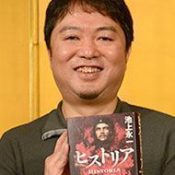
October 24, 2017 Ryukyu Shimpo
The 8th annual Futaro Yamada literary award ceremony was held on October 23 at a hotel in Tokyo.
Historia (Kadokawa), written by 47-year old novelist Eiichi Ikegami from Naha City, was selected as the winner.
It has been regarded as the most interesting popular fiction novel in the past year.
This is the first time a novelist from Okinawa has won this award.
Ikegami said with a smile that his novel, which centers around Colonia Okinawa in Bolivia, will be enjoyable for the people of Colonia Okinawa.
Kadokawa established the Futaro Yamada award in 2009 to discover promising authors who may follow in the footsteps of leading postwar Japan popular fiction author Futaro Yamada.
The selection committee took notice of Ikegami’s novel in part because it “conveys the message that the war is ongoing in Okinawa.
” With the stage set in Bolivia, Historia tells a tale of Mabui, whose family was lost in the Battle of Okinawa. Ikegami says Historia is distinct from his novels The Tempest and Léquios, which are set in Okinawa.
(English translation by T&CT and Erin Jones)
Go to Japanese

October 19, 2017 Ryukyu Shimpo
Operations of CH-53E heavy-lift transport helicopters at Futenma Air Station were suspended following the recent incident of a U.S. military helicopter catching fire in Takae, Higashi Village.
On October 18, the U.S. Marine Corps resumed flights of these aircraft. In response to this, Governor Takeshi Onaga expressed for the first time his intention to demand removal of the six helipads in the Northern Training Area (NTA), which envelops Takae.
Onaga said to a group of reporters: “We feel [the helipads] should not be used and we earnestly desire their removal.”
Without any explanation from the Japanese government about an investigation into the cause of the accident or preventative measures, the U.S. forcing flight resumption has led to backlash first from within Okinawa, and then from other municipalities in succession.
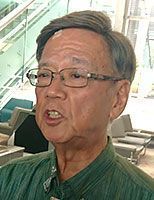
Governor Takeshi Onaga
The U.S. military personnel who have been dismantling the aircraft wreckage on-site appear to have begun hauling the fuselage away as of October 19.
At 10:42 a.m. on October 18, the first CH-53E helicopter since the suspension took off from Futenma Air Station.
In the afternoon there were repeated take-offs and landings of these aircraft.
The aircraft that experienced issues in the sky over Takae was confirmed to be the same model as those which have now resumed operations.
U.S. military personnel have been working with heavy machinery to remove the fuselage from the site of the accident.
On October 18 at the Prefectural Office, officials from the prefectural government and the Okinawa Defense Bureau (ODB) held a press conference in regards to the results of a radiation survey in the vicinity of the wreckage.
They issued a declaration of safety as no abnormal readings were detected at the site. At the Okinawa Prefectural Assembly Building in Naha City, Governor Onaga spoke to a group of reporters and objected to the forced flight resumption, “I absolutely cannot accept the U.S. military’s stance, it’s outrageous.
” He made the point that allowing the U.S. military to respond in this way also throws the Japanese government’s culpability into question.
Therefore he strongly recommended that the government shoulder its responsibility and engage the U.S. persuasively.
Onaga commented further, “There is no way an investigation to determine the cause [of the incident] could be completed under the circumstances.
” Finally, he lamented the current state of affairs in Japan, where the government will push forward as though the investigation into these matters has already finished.
Minister of Defense Itsunori Onodera said to a group of reporters at the Ministry of Defense that the resumption of flights was “regrettable.
” Onodera rejected Onaga’s call for removal of the helipads, explaining that the construction of new helipads was a precondition for the return of more than half of the NTA to Okinawa, which has taken place.
He mentioned his desire to request that the U.S. military take care to conduct its operations safely.
On October 17 the U.S. military explained that the Self-Defense Force personnel dispatched from the Ministry of Defense were engaged in preventative measures and similar activities.
However, Onodera considered the U.S. military’s explanation to be lacking detail.
He said, “My stance that flights should be suspended until safety is confirmed remains unchanged.” Mayor Atsushi Sakima of Ginowan City, where Futenma Air Station is located, said during an interview at Ginowan City Office that, “City residents are feeling anxious.
” He said with resentment, “It is extremely regrettable that flights took place while their safety was not properly confirmed.”
(English translation by T&CT and Erin Jones)
Go to Japanese

October 18, 2017 Ryukyu Shimpo
On October 17, the fourth edition of the 87th Shimpo Women’s Salon talk was held at the Crowne Plaza ANA Okinawa Harborview in Naha City, where actor and TV personality Giry Vincent gave a talk. Giry, who is from France, said, “Okinawan women have a strong sense of independence and are hard workers.
I think there is a lot that they have in common with French (women).” He then spoke of the similarities between Okinawa and France, along with their characteristics.
Taking advantage of studying abroad at Dokkyo University in Saitama Prefecture, Giry began taking on jobs on TV shows and radio programs in Japan.
Right now, he is situated in Tokyo, but spends about 10 days a month in Okinawa, recording TV shows.
Giry and his mother arrived in Okinawa for the first time in 2005, to which he said, “I fell in love with Okinawa. It’s unbelievable how nice it is. It just felt right.”
During his talk, Giry mentioned how he felt Okinawa and France both show similarities in that they have multiple cultures fusing together.
He said, “In France, various people arrive from the north and south.
The fact that it is a culture that has been champurued (“mixed” in Okinawan) makes it similar to Okinawa.”
(English translation by T&CT and Chelsea Ashimine)
Go to Japanese
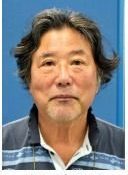
October 15, 2017 Ryukyu Shimpo
By Chie Tome
Many years of large amounts of trash washing in from the ocean and accumulating in the mangrove swamps of Iriomote Island in Taketomi, a potential World Heritage Site, was having a clear effect on the mangrove and the surrounding environment.
This was made clear in a recent survey conducted by National Defense Academy Professor Emeritus Haruyuki Yamaguchi, who chairs the Okinawa Committee to Promote Policies to Prevent Coastal Pollution.
From things such as nets and ropes becoming entangled in the mangrove roots, and materials such as plastic and Styrofoam, which decompose and release hazardous substances, there is a fear that the mangrove ecosystem may be destroyed.
Professor Yamaguchi warned that not only were the mangrove swamps home to the precious Iriomote cat, a protected species, but also, “it is being looked at as a [potential] World Heritage Site, so a viable strategy is an urgent need.”
In order to get a grasp on the reality of trash washing ashore on Iriomote Island, Prof. Yamaguchi conducted a total of 32 surveys of three mangrove swamps, two at the estuaries of the Nakama and Yutsun rivers, and one on the western bank of the Hinai River estuary at Funaura. A total of 98,502 pieces of trash were collected.
The collected garbage was sorted into categories, and the preponderance of plastic such as PET bottles and containers was prominent.
At the time of the first survey in 2004, plastic comprised of 46.9% of the trash collected, which by 2017 is had increased 1.7 times, to 81.5%.
For the unique clumps of brace roots and respiratory roots of mangrove clusters, waste pushed in from the sea is a natural enemy.
If ropes or nets become entangled in the roots, there is no way for them to untangle on their own, damaging their ability to grow.
The northern coast of the island, which includes the Yutsun estuary that faces the most serious pollution, also serves as the habitat for the Iriomote cat.
With this in mind, there is an increased risk of hazardous chemicals that come from the decomposition of waste will contaminate the organisms which make up the food chain that supports the rare, protected cat.
Prof. Yamaguchi indicated that the mangrove roots play an important role, stating, “They act as a protective barrier for the enormous ecosystem by blocking sand and polluted water from the land, and is home for much of the food chain that supports the diverse ecosystem.
” Additionally, he emphasized that in order to sustain one of the world’s rarest natural environments, developing a system to patrol and assess the situation as well as quickly collect and dispose of waste was an urgent issue.
In recent years, due to a worsening of overseas trash from countries such as Korea and China, particularly on isolated islands, Okinawa has been stepping up efforts to combat such waste with measures such as forming committees of specialists.
(English translation by T&CT and Sam Grieb)
Go to Japanese
October 17, 2017 Ryukyu Shimpo
On October 16, the Okinawa Defense Bureau revealed to the Ryukyu Shimpo that earlier this month, it was decided that the Bureau will pay damages to the village of Ginoza in relation to costs incurred by the village after a U.S. military aircraft crash in August 2013.
After the accident, in which an HH-60 rescue helicopter belonging to Kadena Air Base crashed over Camp Hansen, the village was forced to stop water collection from the Okawa dam roughly 70 meters from the crash site and incurred around 6.5 million yen to secure alternate sources of water and conduct other measures.
The decision to pay damages was not made until more than four years after the accident.
Immediately after the accident, the U.S. Marines’ survey of the site revealed levels of lead more than 74 times the environmental standard value set forth in Japan’s Soil Contamination Countermeasures Act, and levels of arsenic more than 21 times the environmental standard value.
Out of concern that rain would cause the contaminants to run into the dam, the village of Ginoza stopped using water supplied from the dam for one year.
During that period, the village incurred roughly 6.5 million yen for water-quality inspections, maintenance fees for the water pump at the Kanna dam, and other measures, and it therefore requested compensation from the national government.
(English translation by T&CT and Sandi Aritza)
Go to Japanese
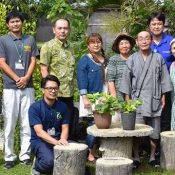
October 5, 2017 Ryukyu Shimpo
On September 27, foster parents of the “Miracle Hydrangea” had a get-together in Kitanakagusuku Village in Okinawa.
The “Miracle Hygrangea” was found at the bottom of the Fujinuma Lake in Naganuma, Sukagawa City in Fukushima Prefecture that had collapsed during the Great East Japan Earthquake in 2011.
Foster parents Toshio, 68, and Hisako Yamazaki, 65, who live in Motomiya City of Fukushima Prefecture visited Youko Higa’s, 67, home in Kishiyaba, Kitanakagusuku Village.
The three smiled at how fate and this plant brought them together.
As a “Symbol of Restoration,” the local Naganuma Commercial and Industrial Association is recruiting foster parents across the country for the “Miracle Hydrangea” and is separating the roots for this purpose.
As of September, about 1,400 foster parents in 18 prefectures are caring for the hydrangea.
Mr. Yamazaki became a hydrangea foster parent after the plant was recommended to him by the sales person when he visited Sukagawa City.
When he participated in the Hydrangea Arbor Day that took place at the Fujinuma Lake Natural Park in June, he learned that there were other foster parents outside of the prefecture.
Mr. and Mrs. Yamazaki wanted to meet with other foster parents within Kitanakagusuku Village.
Using the village’s office as an intermediary, they arranged to visit Higa’s home.
Mr. Yamazaki who saw Higa’s hydrangea said, “I was surprised to see how big it’s gotten.
They seem to be caring for it very well.” Even though they were strangers, Mrs. Yamazaki felt a sense of connection.
Higa smiled as she said, “The hydrangea connects the northeast and Okinawa.
If I have the opportunity, I’d like to visit Fukushima too.”
(English translation by T&CT and Chelsea Ashimine)
Go to Japanese
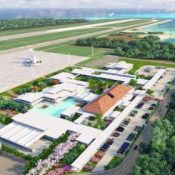
October 12, 2017 Ryukyu Shimpo
On October 11, Mitsubishi Estate, a leading Japanese real estate developer, held a groundbreaking ceremony for the construction of Shimojijima Airport in Miyakojima City.
The organizers wished for a safe construction and for the safety of the passenger terminal.
The facility will be built in a villa resort-style using some wood building materials.
Its opening is scheduled for March 2019.
The company aims for the airport to operate for low-cost carriers (LCC) with overseas air routes from East Asia as well as domestic cities.
The company is also developing a parking business for private jet aircraft.
The company aims for the number of passengers to reach 55,000 people in 2019 and 570,000 people in 2025.
The facility is a one-story building with concrete and timber.
The site area is 31,580 square meters and the facility area is 13,480 square meters. According to Mitsubishi Estate, domestic flights are scheduled to be in service of LCC based in Tokyo, Chubu, and Kansai.
Japan Airlines (JAL) and All Nippon Airways (ANA) will use Miyako Airport.
At first, overseas routes will be launched from Taipei, Hong Kong, Seoul, and other locations.
In domestic airports, there are few places to park private jet airplanes, so some private-jet owners are forced to use overseas airports.
In anticipation of the expansion of the private jet market, the company will develop a parking business at Shimojijima Airport.
(English translation by T&CT and Megumi Chibana)
Go to Japanese
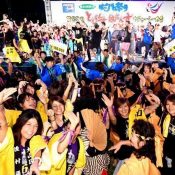
October 2, 2017 Ryukyu Shimpo
The 29th Tobinsu Haninsu Kachaashi festival was held on October 1 at the Ginowan seaside park.
Thirty five individuals and 25 groups entertained the audiences with unique costumes and dances.
The event reached a climax when the performers and audiences danced together in the finale.
In, the Tobinsu section, in which performers danced to original music, Ajikuta’S won its second championship in a row with a performance that combines classical Ryukyuan music and western music. The encouragement prize was given to Yanzaya with OBC.
A 66-year old audience member from Naha city, Masanori Kinjo, smiled as he remarked, “all of the performance was fun and wonderful.
I would like to join next year.” Other winners include the following:
Adults:
Grand prize: Nodake 3-ku Gajimaru team; Gold prize: Oroku zumba; Special prize: Mabuhay Dance Troupe
Kids:
Grand prize: Pikkoro gakudo club ataku No1; Gold prize: Ginowan baseball kids
For individuals:
Grand prize: Takeshi Kinjo; Gold prize: Kazuhiko Taira; Special prize: Yuichi Matsunaga
(English translation by T&CT and Sayaka Sakuma)
Go to Japanese
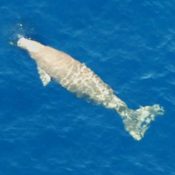
October 17, 2017 Ryukyu Shimpo
By Chie Tome
In order to study the impacts of replacement facility construction in Henoko, Nago City for Futenma Air Station (currently located in Ginowan City), the Ministry of Defense’s Okinawa Defense Bureau (ODB) is conducting a dugong habitat investigation in the surrounding waters.
Due to a dugong’s call recorded on August 28 in Ada, Kunigami Village, it came to light that dugong specimen C, which has not been spotted since June 2015, may still be out there.
The ODB announcement of this finding was recorded in the minutes from the October 10 meeting of the Environmental Oversight Committee in its 9th session (which began on September 27).
In order to identify the dugongs’ habitats and various behavioral tendencies, the ODB is continuing to monitor the dugongs using aircraft and underwater audio recording equipment.
Each specimen cannot be identified based on audio alone, but by observing other dugongs within the same time frame, circumstantially it appears possible that there are only three dugongs in Okinawa, one of them being specimen C.
According to the Environmental Oversight Committee’s minutes, around 10:00 a.m. on August 28 some recording equipment underwater in Ada captured a sound thought to be a dugong call.
However, since a surveying helicopter observed specimen B in the waters of Kouri at 9:53 a.m. the same day, the ODB has surmised that the dugong call captured was not from specimen B.
Based on recordings up to this point, the range of specimen A’s habitat is generally limited to the water area of Kayo.
Therefore, committee members have indicated the recording in Ada is likely the call of specimen C.
The ODB is taking another angle due to difficulties in identifying specimens based on their calls: “This may be specimen C, but we are not ruling out the possibility that it was specimen A.”
What seem to be dugong calls were recorded in Ada’s waters in the afternoon on August 29 and 30, as well.
Director Mariko Abe of the Nature Conservation Society of Japan said, “If specimen C is confirmed I will be delighted, but still the objective of the underwater audio recording equipment is unclear.”
She mentioned that above collecting weak call recordings to identify specimens, “It is essential to take effective conservation measures.”
(English translation by T&CT and Erin Jones)
Go to Japanese














 Webcam(Kokusai Street)
Webcam(Kokusai Street)


